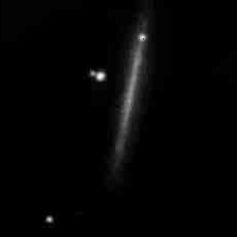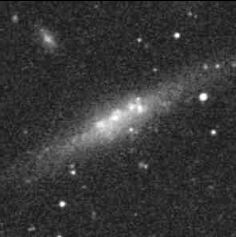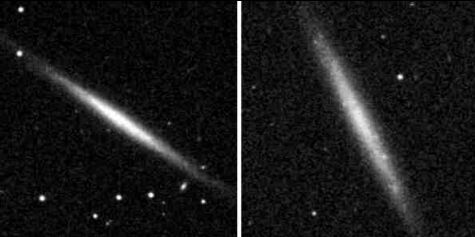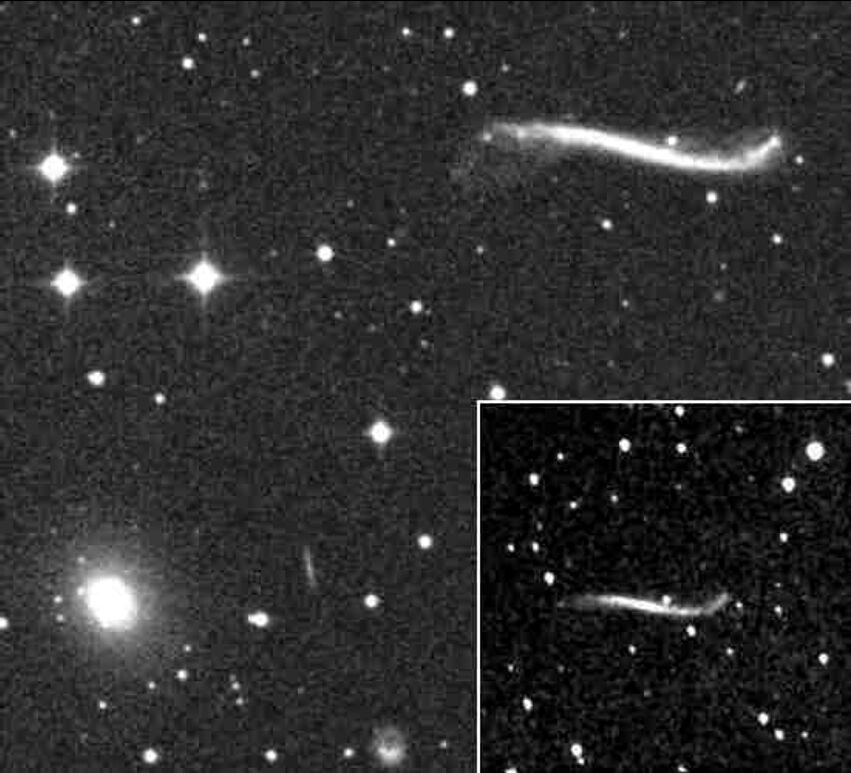
"Superthin Galaxies" - Objects, Sharp as a Razor Blade
Wolfgang Steinicke
Preliminary stage: edge-on galaxies
Since I first observed the sky through a telescope, galaxies are fascinating me in their various forms, shapes, and orientations. Many deep-sky fans are enthusiastic about edge-on galaxies, e.g. spirals with a disc seen nearly from the edge. In this case dust bands and the central bulge are dominant features. In the classic Hubble Atlas of Galaxies [1], a book you cannot escape from in your life, there are pretty examples. All galaxies are shown in black & white images, mostly taken at Mount Palomar. While I visited the observatory in 2000, I remembered some of these pictures and must admit, that those classical photos impress me more than modern color CCD-pictures from the HST or VLT. This might be pure nostalgia. Also the big dome of the 200 inch, the very cathedral of astronomy, does - literally - outshine all what I've seen so far (modern, azimutal mounted teleskopes need much less space).
Back to the edge-on's. Images are one thing, visual observations are still another: influenced by the great Palomar pictures I was really impressed looking at edge-on galaxies through a large amateur telescope for the first time. For beginners I must state, that the very feeling will only come up, if one gets to large apertures step by step. Otherwise the visual impression will be rather dissapointing. Fortunately the correct way results naturally through one's increasing financial power. It is always fascinating to see a galaxy as a narrow streak of light with a dusty edge and an oval center standing out against the dark sky - prominent examples are NGC 891, NGC 4565 or NGC 5907 [2]. Therefore edge-on galaxies are popular and often-sketched deep-sky objects [3]. The difference between drawings made at a large Dobson and images from the Hubble Atlas is not large at all. Beautiful examples can be found in interstellarum 12 and 13 [4], in particular NGC 4244 is a most remarkable case.
The nature of "superthin galaxies"
As a cataloger I first assembled a list containing the most interesting edge-on objects, beeing a source for systematic observations. In the early 80s I noticed a paper on "superthin galaxies" (in short SGs) by Goad and Roberts - they introduced the term -, which immidiately casts a spell over me [5]. In contrast to ordinary edge-on galaxies, SGs are extreme cases, fitted out with some peculiarites. Defined through an axial ratio of 8:1 or more, they lack of a bulge and a dust-ring. In some cases the thin disc is "warped ". These galaxies mostly belong to the late types Sc, Sd or Sm. They are underdeveloped systems, simple featureless discs showing a flat rotation curve. Due to a small amount of interstellar matter, the internal extinction is low and also the star formation rate is minimal. The resulting low stellar density causes a low surface brightnes. Many systems are classified as nearby dwarf galaxies. From their spatial distribution it follows, that these "retarded types" are most common objects in the cosmos.
Many SGs are not listed in the NGC/IC. Due to their extreme flattening, with ratios up to 20:1, they might often be overlooked visually, despite of an otherwise moderate total magnitude. In fact, a considerable amount were not recognized by the visual observers contributing to the NGC/IC [6]. But they are visible on the Palomar Observatory Sky Survey (POSS) and therfore many are included in Nilson's Uppsala General Catalogue of Galaxies (UGC), containig all northern galaxies (decl. > -2,5°) larger than 1' or brighter than 14.5mag. Also Fritz Zwicky - a great fan of morphology - was interrested in this type and he has found some extremely formed systems inspecting the 48"-Schmidt POSS-plates.
Let's take a look on the four systems discussed by Goad and Roberts (Fig. 1). The prototype might be IC 2233 in Lynx. This galaxy was discovered in 1897 on a plate by Isaac Roberts (interesting coincidence of names!), an english pioneer of astrophotography. Boris Vorontsov-Velyaminov (1967) and a little later Gerard deVaucouleurs became aware of this system due to its immense flatness. They also found two other examples: UGC 7321 and UGC 9242. UGC 9242 has a brightness of V=13.5mag (Typ Sd) and is 5' long with an axial ratio of nearly 17:1! It is listed in Zwicky's catalogue of compact and post-eruptive galaxies as I Zw 88 and his description reads: "extremely flattened blue galaxy with many faint stellar knots". Very similar appears the V=13,4mag Sd-galaxy UGC 7321. The fourth system, with a slightly warped disc is UGC 7170. This feature is even more prominent in the "integral-sign galaxy" UGC 3697, which might be seen as a limiting case of a superthin galaxy. Geoffrey Burbidge has first studied the object in 1967, naming it GB 1, until it was later found to be identical with MCG 12-7-28, a galaxy discovered by Vorontsov-Velyaminov's in 1962. By the way, the Hipparchos data suggest, that the Milky Way has a weak warped-disc structure too.

Fig .1 - The four "superthin galaxies" discussed in Goad & Roberts' paper [5]. From left: IC 2233 in Lynx (see Fig. 2), UGC 7170 in Coma Berenices with a weak warped-disc feature, UGC 7321 in Coma Berenices and UGC 9242 in Bootes.
Visual observations and CCD-images
The aim of this paper is to support amateur observations of these interesting objects, both visual (with apertures of 12" or more) and with CCDs. At present they are quite rare. I have listed some remarkable targets in Tab. 1. The visual observation of SGs needs some sure instinct - one has to be prepared what could be seen. A similar situation is in the case of faint stellar objects, like quasars [7]. The major problem is the low surface brightnes. As a definite center is not present, the light is smeared over the narrow line. This often requires indirect viewing and the sky background must be dark to produce enough contrast. One example is my observation of IC 2233 (Fig. 2). I searched for the object with low magnification (100x) and it was helpful to move the telecope vertical to the thin disc, the eye then stumbles over the line. With higher magnification (266x) the object was easy to fix. By the way, around 15' north there is the peculiar "pear paw galaxy" NGC 2537 = Arp 6. Both objects were also observed by Jim Meketa with 18" [8].

Fig. 2 - Sketch of IC 2233 made at a C-14 with 266x (February, 24 1984). Under optimal conditions the object appears as a thin diffuse line without center.
Many objects are quite extended and the field of view must be large enough. It is therefore useful to test different magnifications. With high power only the central region is present, often not much brighter than the rest. An interesting example is UGCA 320, a flat disc with many knots (Fig. 3). There is no real bulge, and so this dwarf can be seen as a limiting case of a SG, despite of its lower axial ratio.
The brightest object in the table is NGC 5023 in Canes Venatici with V=12.3mag. This is not caused by a higher luminosity. The galaxy is not far away, belonging to the M 51-group. Even in a C-14 this Scd-galaxy is not an easy target, the surface brightnes is pretty low. As Fig. 4 shows, the nominal brightnes (see Tab. 1) is often not a reliable measure for the optical appearence. This is particularly true for visual observations, so one must try to find out what's really possible.

Fig. 3 - UGCA 320 in Virgo, a limiting case of a SG. It is a disclike dwarf galaxy (DDO 161) with a center containing bright knots.

Two objects are also contained in Steve Gottlieb's „torture lists". To punish the inferior deep-sky crowd, my friend Steve continuously presents „off the beaten path" targets (he observes from dark californian sites with a 17.5" Dobson). The galaxies are NGC 100 in Pisces and the above mentioned "integral-sign" UGC 3697 in Camelopardalis. He describes NGC 100 (Fig. 4) as "very faint, elongated 6:1, WSW-ENE, 2.0' x 0.3', weak concentration". This shows how difficult it can be to see an object with V=13.3mag. The rules for SGs are different! UGC 3697, with V=12.9mag even brighter, is described as "very faint, extremely thin ghostly streak oriented WSW-ENE, at least 2.5' x 0.3', low surface brightness, no significant concentration towards the center". With 100x he found the object difficult to see, it was easier with 220x. The curved ends of the disc were not visible. I observed the object first on December, 2 1983 and my impression was quite similar to Steve's. The observation was part of my galaxy group-project. UGC 3697 is a member of KDG 49 (Catalogue of Galaxy Groups) and belongs also to the "nearby poor cluster" WBL 132 [9]. 8' SE there stands UGC 3714, a galaxy with V=12.1mag, visually much easier. There might be a gravitational interaction between both systmes, which could be the reason for the warped-disc of UGC 3697 (Fig. 5). Mike Borman has made a nice CCD-image in 1998 (Fig. 5 inset). By the way, the "integral-sign" was a competitor in the Hubble Heritage Project (you can propose you favorite object there for taking a picture with the HST). In the end there was a bare majority for the polar ring-galaxy NGC 4650A.

Fig. 5 - The prominent "integral-sign galaxy" UGC 3697 and its companion UGC 3714 (KDG 49 in Camelopardalis). Inset: Mike Bormann's CCD-image made with ST-7 at a 12" Meade LX-200 (Evansville/Indiana, 1998).
The actual source for "flat" galaxies, where all of our objects are included, is Igor Karachentsev's Revised Flat Galaxy Catalogue (RFGC) from 1999 [10]. He has scanned the sky surveys for galaxies larger then 40" and a minimum axial ratio of 7:1. The RFGC contains 4444 objects - enough stuff for further observations and images. With modern equipment (Dobson, CCD) any success is possible. Looking at recent CCD-images, there is no real qualitative difference between these and the analog POSS I, though the mirror area of the Palomar Schmidt is 16 times larger! It is rewarding to join hunting SGs - I'm eager to see the results.
Tab. 1 - Examples of "superthin galaxies" (SGs). Objects No. 4, 5, 6 and 10 are from the paper of Goad [5]. No. 3 and 8 are limiting cases. RFGC = number in the Revised Flat Galaxy Catalogue [10]; V = visual magnitude; V' = surface brightnes (mag/arcmin2); a, b = size (arcmin); PA = position angle (°).
|
Object
|
RFGC
|
Con
|
Rect (2000) Decl
|
V
|
V'
|
a x b
|
a/b
|
PA
|
Type
|
|
|
1
|
NGC 100 |
95
|
PSC
|
00 24 02.7 +16 29 11 | 13.3 | 14.5 | 6.16 x 0.64 |
9.6
|
55
|
Sc
|
|
2
|
UGC 711 |
255
|
CET
|
01 08 37.0 +01 38 29 | 13.8 | 14.3 | 4.65 x 0.30 |
15.5
|
118
|
Scd
|
|
3
|
UGC 3697 |
1172
|
CAM
|
07 11 19.2 +71 50 13 | 12.9 | 12.2 | 3.23 x 0.29 |
11.1
|
90
|
Sd
|
|
4
|
IC 2233 |
1340
|
LYN
|
08 13 59.5 +45 44 34 | 12,6 | 13.3 | 5.17 x 0.58 |
8.9
|
173
|
Scd
|
|
5
|
UGC 7170 |
2210
|
COM
|
12 10 36.0 +18 49 44 | 14.3 | 13.4 | 3.25 x 0.28 |
11.6
|
12
|
Scd
|
|
6
|
UGC 7321 |
2246
|
COM
|
12 17 33.8 +22 32 25 | 13.4 | 13.7 | 5.54 x 0.36 |
15.4
|
81
|
Sd
|
|
7
|
UGC 8146 |
2443
|
UMa
|
13 02 07.9 +58 41 59 | 13.8 | 14.3 | 3.92 x 0.32 |
12.3
|
31
|
Scd
|
|
8
|
UGCA 320 |
2449
|
VIR
|
13 03 17.0 -17 25 23 | 12.5 | 14.7 | 8.01 x 1.06 |
7.6
|
115
|
Sdm
|
|
9
|
NGC 5023 |
2496
|
CVn
|
13 12 11.8 +44 02 17 | 12.3 | 14.0 | 7.28 x 0.78 |
9.3
|
28
|
Scd
|
|
10
|
UGC 9242 |
2774
|
BOO
|
14 25 21.6 +39 32 24 | 13.5 | 13.7 | 5.66 x 0.34 |
16.6
|
71
|
Sd
|
|
11
|
UGC 9977 |
3021
|
SER
|
15 42 00.0 +00 42 48 | 13.2 | 13.4 | 4.26 x 0.40 |
10.7
|
77
|
Sc
|
|
12
|
UGC 12423 |
4081
|
PSC
|
23 13 13.2 +06 25 48 | 13.6 | 13.7 | 4.70 x 0.45 |
10.4
|
145
|
Sc
|
Literature
[1] A. Sandage, The Hubble Atlas of Galaxies, p. 25
[2] W. Steinicke, Deep-Sky auf dem Schauinsland, Sternzeit 3/2000, p. 106
[3] Tom Polakis, Edge-on Galaxies of Spring, Sky & Telescope, April 1996, p. 92
[4] R. Stoyan, Album der Edge-On-Galaxien, Part I: interstellarum 12, p. 28 (1997), Part 2: interstellarum 13, p. 43 (1998)
[5] Goad, J.W., Roberts, M.S., Spectroscopic Observations of Superthin Galaxies, Astrophys. J. 250, 79 (1981); a short abstract is given in Sky & Telescope, March 1983, p. 252
[6] W. Steinicke, Digital Deep-Sky Data, Visual Observing and the NGC/IC-Project, VdS-Journal, Summer 2000, p. 49
[7] W. Steinicke, Im Quasar-Fieber, interstellarum 14, p. 24 (1998)
[8] Jim Meketa, Deep Sky Magazine, 10, 32 (1985)
[9] White, R.A., et al., Catalogue of Nearby Poor Clusters of Galaxies, Astron. J. 118, 2014 (1999).
[10] Karachentsev, I., et al., Revised Flat Galaxy Catalogue, Bull. Special Astrophys. Obs., 47, 5 (1999). The FGC appeared in Astron. Nachr. 314, 97 (1993).